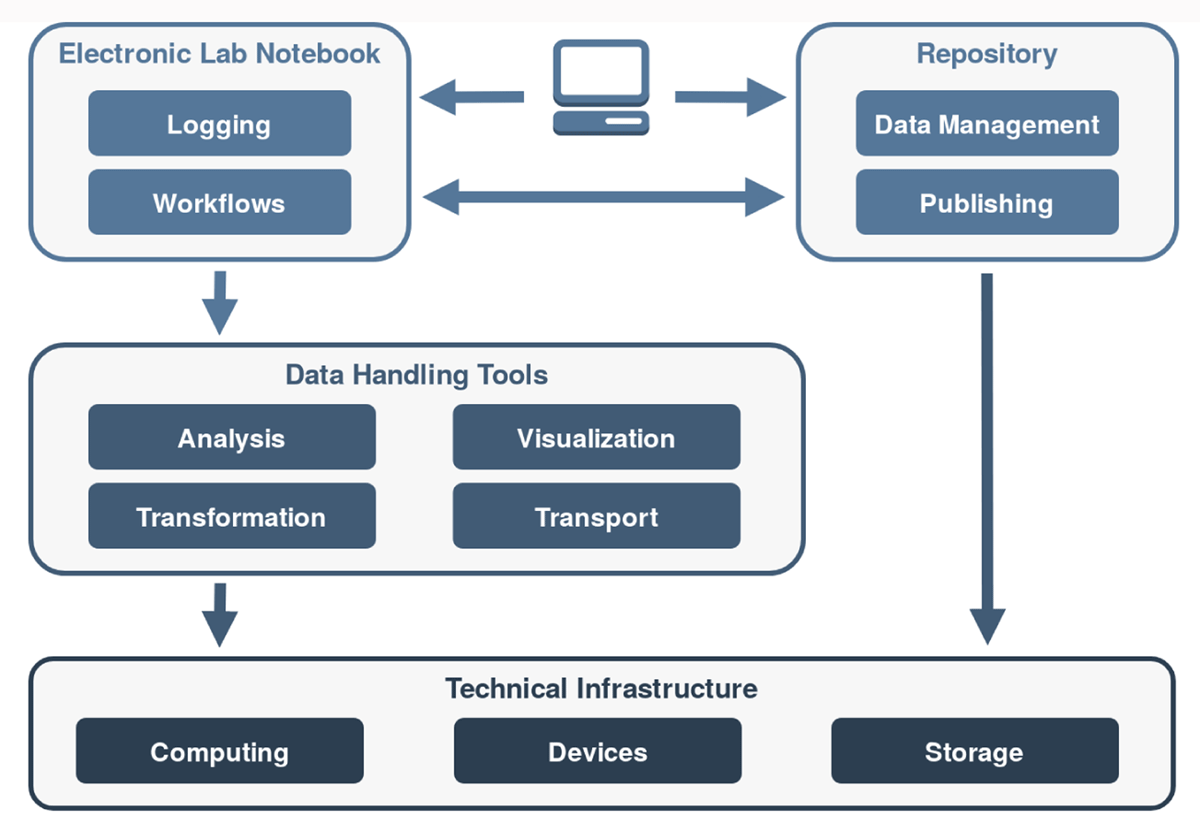Difference between revisions of "Template:Article of the week"
Shawndouglas (talk | contribs) (Updated article of the week text) |
Shawndouglas (talk | contribs) (Updated article of the week text) |
||
| Line 1: | Line 1: | ||
<div style="float: left; margin: 0.5em 0.9em 0.4em 0em;">[[File:Fig1 Brandt DataSciJourn21 20-1.png|240px]]</div> | |||
'''"[[Journal: | '''"[[Journal:Kadi4Mat: A research data infrastructure for materials science|Kadi4Mat: A research data infrastructure for materials science]]"''' | ||
[[ | The concepts and current developments of a research data infrastructure for [[Materials informatics|materials science]] are presented, extending and combining the features of an [[electronic laboratory notebook]] (ELN) and a repository. The objective of this infrastructure is to incorporate the possibility of structured data storage and data exchange with documented and reproducible [[data analysis]] and [[Data visualization|visualization]], which finally leads to the publication of the data. This way, researchers can be supported throughout the entire research process. The software is being developed as a web-based and desktop-based system, offering both a graphical user interface (GUI) and a programmatic interface. The focus of the development is on the integration of technologies and systems based on both established as well as new concepts. Due to the heterogeneous nature of materials science data, the current features are kept mostly generic, and the structuring of the data is largely left to the users. As a result, an extension of the research data infrastructure to other disciplines is possible in the future. The source code of the project is publicly available under a permissive Apache 2.0 license. ('''[[Journal:Kadi4Mat: A research data infrastructure for materials science|Full article...]]''')<br /> | ||
<br /> | <br /> | ||
''Recently featured'': | ''Recently featured'': | ||
{{flowlist | | {{flowlist | | ||
* [[Journal:Making data and workflows findable for machines|Making data and workflows findable for machines]] | |||
* [[Journal:Timely delivery of laboratory efficiency information, Part I: Developing an interactive turnaround time dashboard at a high-volume laboratory|Timely delivery of laboratory efficiency information, Part I: Developing an interactive turnaround time dashboard at a high-volume laboratory]] | * [[Journal:Timely delivery of laboratory efficiency information, Part I: Developing an interactive turnaround time dashboard at a high-volume laboratory|Timely delivery of laboratory efficiency information, Part I: Developing an interactive turnaround time dashboard at a high-volume laboratory]] | ||
* [[Journal:Advanced engineering informatics: Philosophical and methodological foundations with examples from civil and construction engineering|Advanced engineering informatics: Philosophical and methodological foundations with examples from civil and construction engineering]] | * [[Journal:Advanced engineering informatics: Philosophical and methodological foundations with examples from civil and construction engineering|Advanced engineering informatics: Philosophical and methodological foundations with examples from civil and construction engineering]] | ||
}} | }} | ||
Revision as of 17:30, 20 December 2021
"Kadi4Mat: A research data infrastructure for materials science"
The concepts and current developments of a research data infrastructure for materials science are presented, extending and combining the features of an electronic laboratory notebook (ELN) and a repository. The objective of this infrastructure is to incorporate the possibility of structured data storage and data exchange with documented and reproducible data analysis and visualization, which finally leads to the publication of the data. This way, researchers can be supported throughout the entire research process. The software is being developed as a web-based and desktop-based system, offering both a graphical user interface (GUI) and a programmatic interface. The focus of the development is on the integration of technologies and systems based on both established as well as new concepts. Due to the heterogeneous nature of materials science data, the current features are kept mostly generic, and the structuring of the data is largely left to the users. As a result, an extension of the research data infrastructure to other disciplines is possible in the future. The source code of the project is publicly available under a permissive Apache 2.0 license. (Full article...)
Recently featured:
- Making data and workflows findable for machines
- Timely delivery of laboratory efficiency information, Part I: Developing an interactive turnaround time dashboard at a high-volume laboratory
- Advanced engineering informatics: Philosophical and methodological foundations with examples from civil and construction engineering










